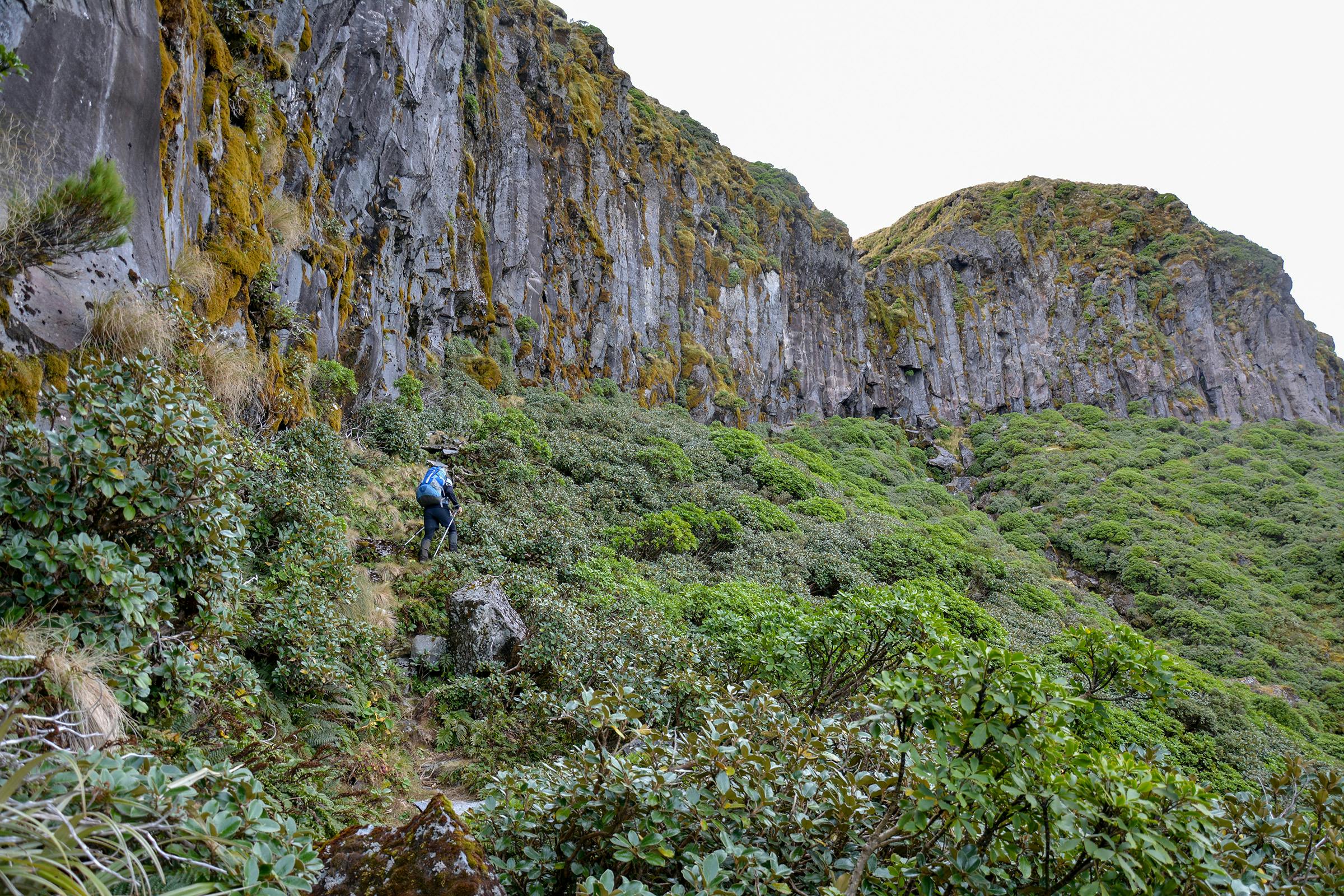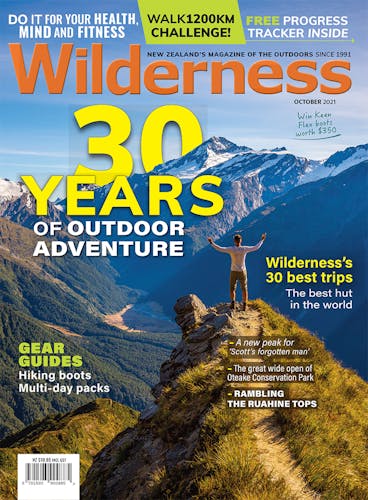Hazel Phillips walks Taranaki’s Around the Mountain Circuit and traces the last steps of the Reverend William Murray who disappeared in 1923
To mark Wilderness magazine’s 30th anniversary, current and past editors and contributors scoured the archives for the 30 best trips we’ve published over the decades. This story, original published in July 2020, was included. You can find all 30 of the greatest Wilderness trips in the October 2021 issue.
If Taranaki were an animal, it would be the Irukandji – a jellyfish, seldom actually seen, whose size is disproportionate to its danger. The Irukandji, according to survivors of its sting, produces ‘a dizzying whorl of horrendous pain’, including muscle and joint aches and an impending sense of doom.
I reckon I came close to death by Irukandji on a sailing trip in the Whitsundays in 2007 – I was about to jump into the water when our skipper pulled up the anchor and shifted the boat, to reveal in the sunlight that the channel we were anchored in was stuffed with jellyfish of all kinds.
As far as doom goes, I’ve been terrified of Taranaki Maunga since the deaths of two climbers near the summit in 2013. I don’t tell my tramping buddy Jean about my fear, or about the fact that I’m using our Around the Mountain trip as a dodgy sort of aversion therapy. (She’ll find out when she reads this story. Sorry Jean.)
Instead, I sell her on the idea that we’ll be chasing the threads of the Reverend William Murray, who went missing on Taranaki in 1923 and whose remains have never been found. Or at least, not all of his remains.
It’s a clear forecast of four or five days of sunshine and no wind when we set off from Dawson Falls. Along with our objectives of aversion therapy and trying to find the Reverend’s bones, I’m also experimenting with dehydrating my own food, interested to see what I can get my nutrition packs down to (small and light), and still be able to tramp with reasonable energy. It’s survivalism of a sort, backed up by two packets of emergency two-minute noodles. I’ve dehydrated everything from brown rice to spinach, hummus, canned tomatoes and even a green smoothie. It’s a test to see how far and long I could theoretically tramp without needing to resupply my food.
With compliant weather conditions, we make excellent time on the upper mountain tracks around to Holly Hut, broken up by a lunch stop at Tahurangi Lodge. There, we can see all the way to the central plateau’s volcanoes. In sharp contrast to Taranaki, the sides of Ruapehu slope away gently: I relate to Ruapehu as a female, but I am acutely aware that ‘he’ was part of the battle for the affections of the nearby, fern-covered sexy Pihanga.
It’s a reasonable day to Holly Hut, where we sneak in under the level two restrictions of 10 people in the hut, with a few late stragglers pushing it over the limit to 13, but nobody really seems to care, sitting in front of a roaring fire with a frost already forming on the grass outside. Crackable ice forms over puddles and those who fill up their bottles early are thankful as the water tank freezes before we get to bed.
I’ve teased the story of the Reverend to Jean already and she demands the details once we’re tucked up dry and warm in the bunkrooms. (Dehy dinner: a successful effort of pasta, dehy tomato pasta sauce, veges and dehy capers.)
In January 1923, the Reverend William Murray left Dawson Falls at 4.45am for the summit with three friends, intending to descend to North Egmont. They summitted at 9.30am, ate an early lunch, then went to descend. But Murray didn’t want to stick to the plan to head to North Egmont and insisted on taking a different route at right angles to the North Ridge Track.
Visibility deteriorated. His friends protested. The route they were attempting went down a compressed and rock-walled snowfield littered with the carcass of the cliffs falling from above. But Murray was determined and refused to retreat. One man went back to Dawson Falls to raise the alarm, while the other two followed for a while, shouting at Murray, although he refused to respond. The others reached Dawson Falls again at 7pm and raised the alarm the next day when Murray didn’t emerge.
Murray, who was one of the founders of the Highlander condensed milk brand, was also a businessman who was described as ‘stalwart’, fit and sturdy, and determined. But heavy rain began to fall on the mountain and he was lost in an area that was wild and bleak, scattered with tough scrub. Wind off the sea would be funneled up the ravines between the spurs.
Searchers, exhausted, tracked him for days afterwards, finding traces of his travels: purposely broken branches, leaves, footprints, the remains of a small fire and a piece of cord tied to some scrub. They discovered two of his camping spots. He was headed towards Bells Falls and The Dome, near Holly Hut, an area featuring bluffs, gorges and tough terrain. Eventually, searchers concluded he had been lost near Bells Falls. There, they found the sole of a boot, marked with indelible ink ‘W.T.M. Jan. 31st’ – the date he’d gone missing – tied to two branches bent across the path and swinging conspicuously in the wind. They concluded he’d been swept over Bells Falls. After fruitlessly bombing the pool at the base of the falls with gelignite in an attempt to dislodge his body, they abandoned the search on February 20.
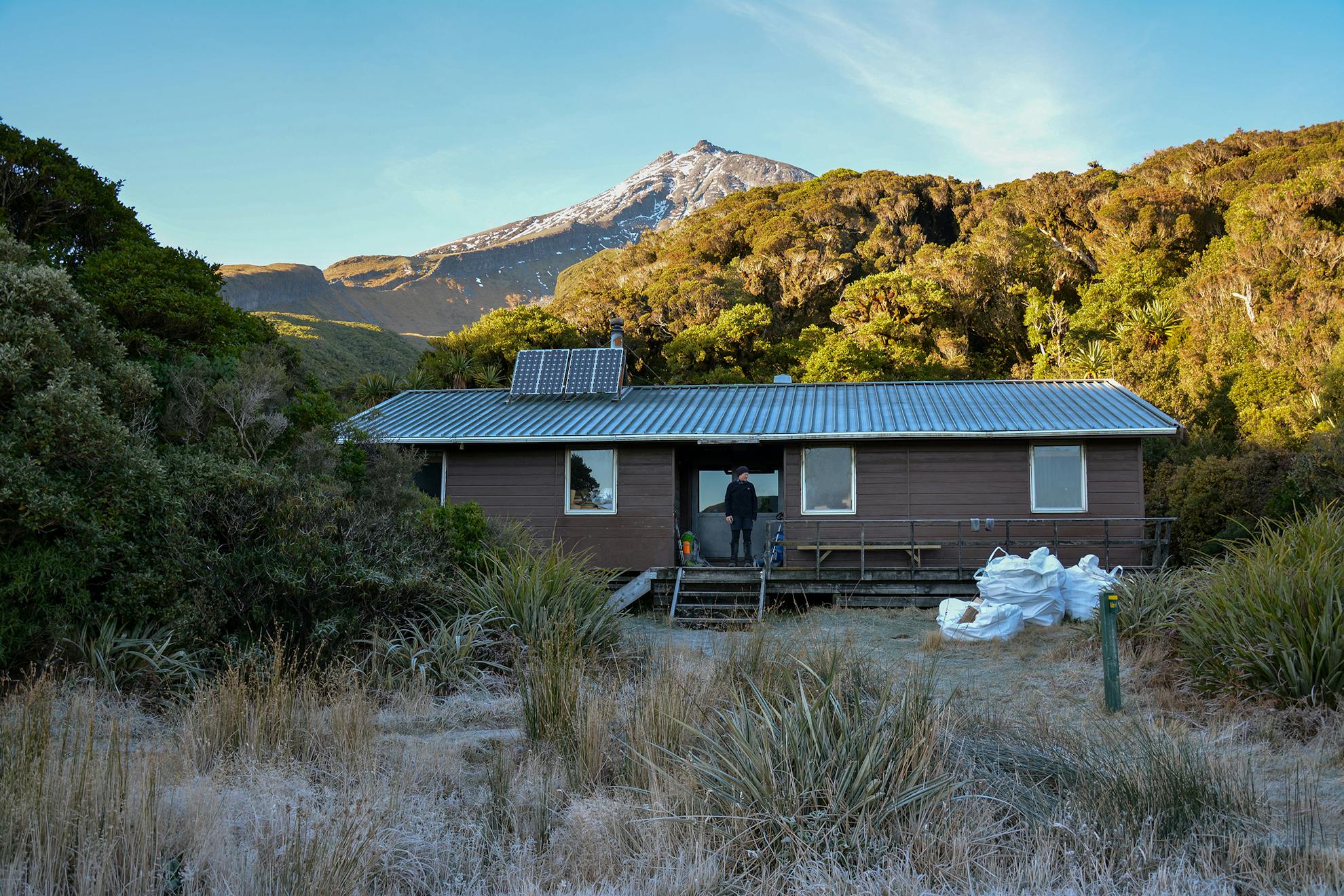
Something’s afoot
Our second day dawned with a frost, clear skies and sunshine emerging centimetre by centimetre to eventually defrost our merino-clad bodies as we warmed up aching muscles with a slow plod down to Bells Falls, a side trip on the track from Holly Hut to Waiaua Gorge Hut. A piece of blue tape was tied to scrub on my left, the only one I saw on this track, but I initially wrote it off as a trap line.
Jean photographed Bells Falls and I thought a lot about how the Reverend would have fared in this spot. The falls are in a V shape, violently carved out of the rock, spilling down and punching into the pool. This is the headwaters of the Stony River, true to its name, littered with boulders and rocks to break anyone travelling down it – by choice or otherwise.
“I guess there wouldn’t be much left of a body after it’s gone over the falls and down the river,” I said to Jean, who told me bodies can stay in one piece after an initial impact but once the bones are broken, there’s not much to hold it together. It’s possible the Reverend fell to pieces fairly quickly if he got bumped over the falls and washed down the Stony River in torrential rain.
Just over a year after the Reverend’s disappearance, a group of men from the Taranaki County Council working in the Stony River found a tweed jacket, then a boot – with a human foot inside, clad in a sock. It was assumed to be Murray as no-one else had been reported missing on the mountain since his disappearance – and he had been wearing a dark tweed suit on the climb.
“A foot would stay in the boot quite easily,” Jean said. “The boot sort of holds it in there.”
I was still thinking about the Reverend and his last journey as we turned off the Stony River Track and came to a track junction where the Puniho Track (straight up) meets the Kapoaiaia Track (across the mountain). I’d done the Kapoaiaia Track eight years ago and what memory I had of it was prompting me to suggest going via Kahui Hut. And anyway, I hadn’t bagged that hut yet. (The Kapoaiaia Track ostensibly maintains the same contour line as it cuts across the mountain’s flanks, but it scrambles down and out of endless stream beds.) A warning sign cemented our decision.
At around 960m, the track takes a sharp, 90-degree right turn, often a sign that another track used to intersect with that and you’re standing at the T junction. Peering into the scrub, a ‘Danger’ sign well hidden amongst the greenery confirmed my suspicions. Another piece of blue tape highlighted the connection, and checking an old map (as late as 1989, but the junction also features in the Lonely Planet guide from 2006) confirmed that an upper mountain track used to run from Holly Flat, skirting the Little Pyramid and linking up to the Kahui Track.
It’s possible the Reverend fell to pieces
if he went over the falls and down the Stony River
Searchers found evidence that the Reverend had picked up this track in his wanderings in the days after going missing. I wonder if he was plagued with a sense of impending doom.
Things change over the years, of course, not just tracks but also huts; we pass the concrete remains of the old Oaonui Hut before reaching Waiaua Gorge Hut, where we chatted in the firelight with two locals.
My dehy dinner is brown rice, vegetables and an un-dehydratable sachet of flavoured tuna. I decided I could go without the tuna.
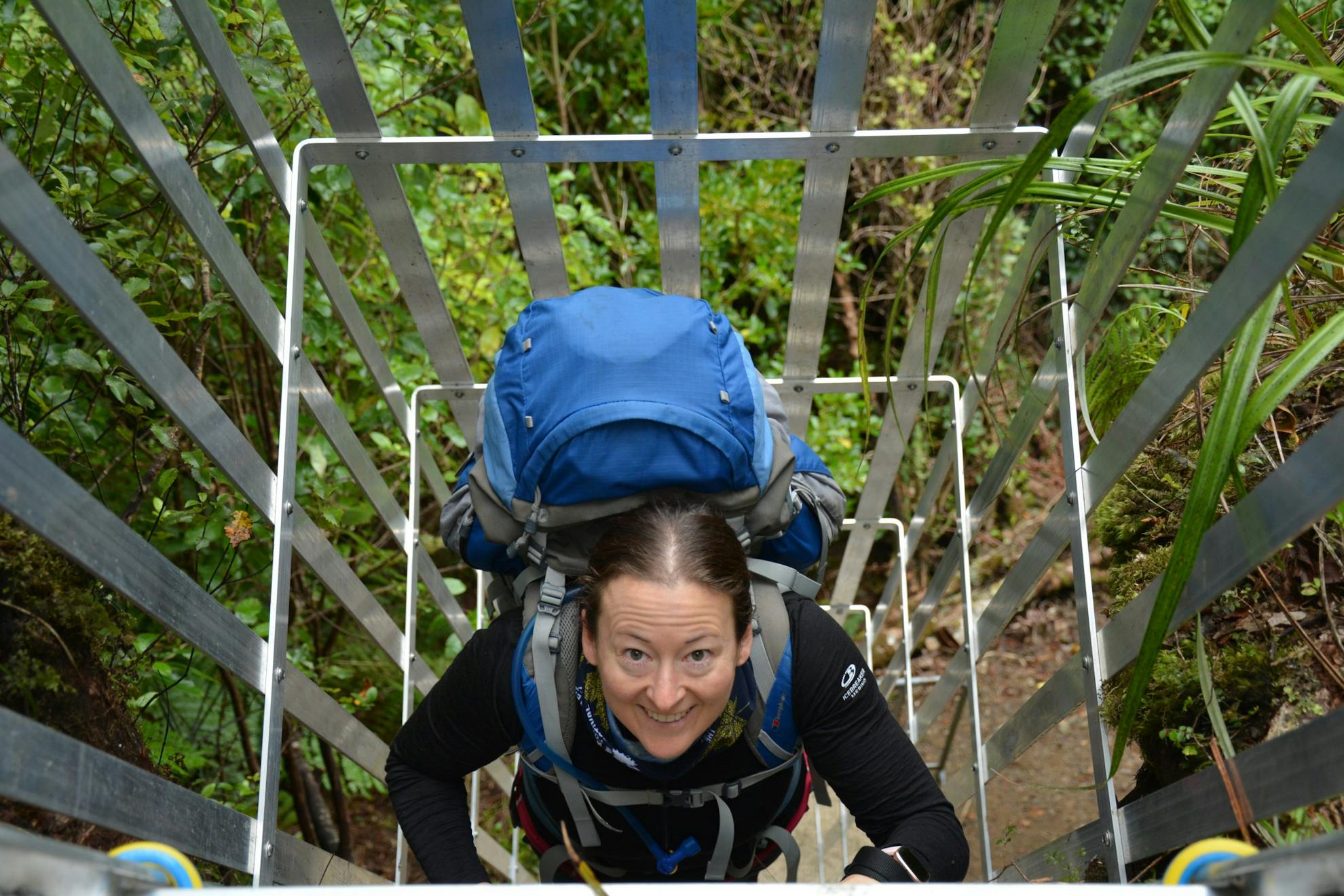
Crumbling cliff carcasses
I was grateful for a warmer, frost-free start the next morning. The mountain was capped with cloud and mist, which soon burned off but made for a moody atmosphere. We opted for the upper track, the Brames Falls Track, which climbs steadily then sharply towards a set of cliffs at around 1300m.
I’d done the Around the Mountain Circuit once before – intending to do it alone, two friends decided to join me, and I recall having a come-to-Jesus moment at these cliffs, thankful I wasn’t rolling solo in such foreboding terrain. The occasional piece of rock sits on the track as the cliffs and mountain shed its skin, and we moved swiftly along.
In and out of eroded gullies and down, down to Lake Dive Hut for night three. Lake Dive is named after Bradshaw Dive, an MP for the Reform Party and mountaineer, who claimed he spotted the lake on a summit trip. His companions reckoned it was a mirage, but it was later confirmed. The lake is cold and I’m reliably informed that the bottom is muddy. It’s May, we’ve had frost, and I’m not that keen to find out. It does, however, give a reflection photo opportunity to rival the usual Pouakai Tarn snap from the other side. The western and southern sides are less known, less trodden – and given how rugged and unforgiving the terrain is, I’m not surprised.
Dehy dinner is another serve of brown rice, veges and tuna, and I conclude firmly that the tuna is too much, especially given I have four lines of white chocolate to finish off and I just need the bare bones, really. We chat to hut occupants, retire from the fire, and mentally prepare ourselves for the final push out via the lower track. The forecast looks like it will turn, but perhaps not until the afternoon.
It doesn’t happen, of course. After three days of good weather that lulled us into a false sense of windless, cloudless security, Taranaki serves up a dish of un-dehydrated rain and wind, as if to say, don’t let the door hit you in the arse on your way out. Taranaki, with a sting in its tail, simply has to have the last word.
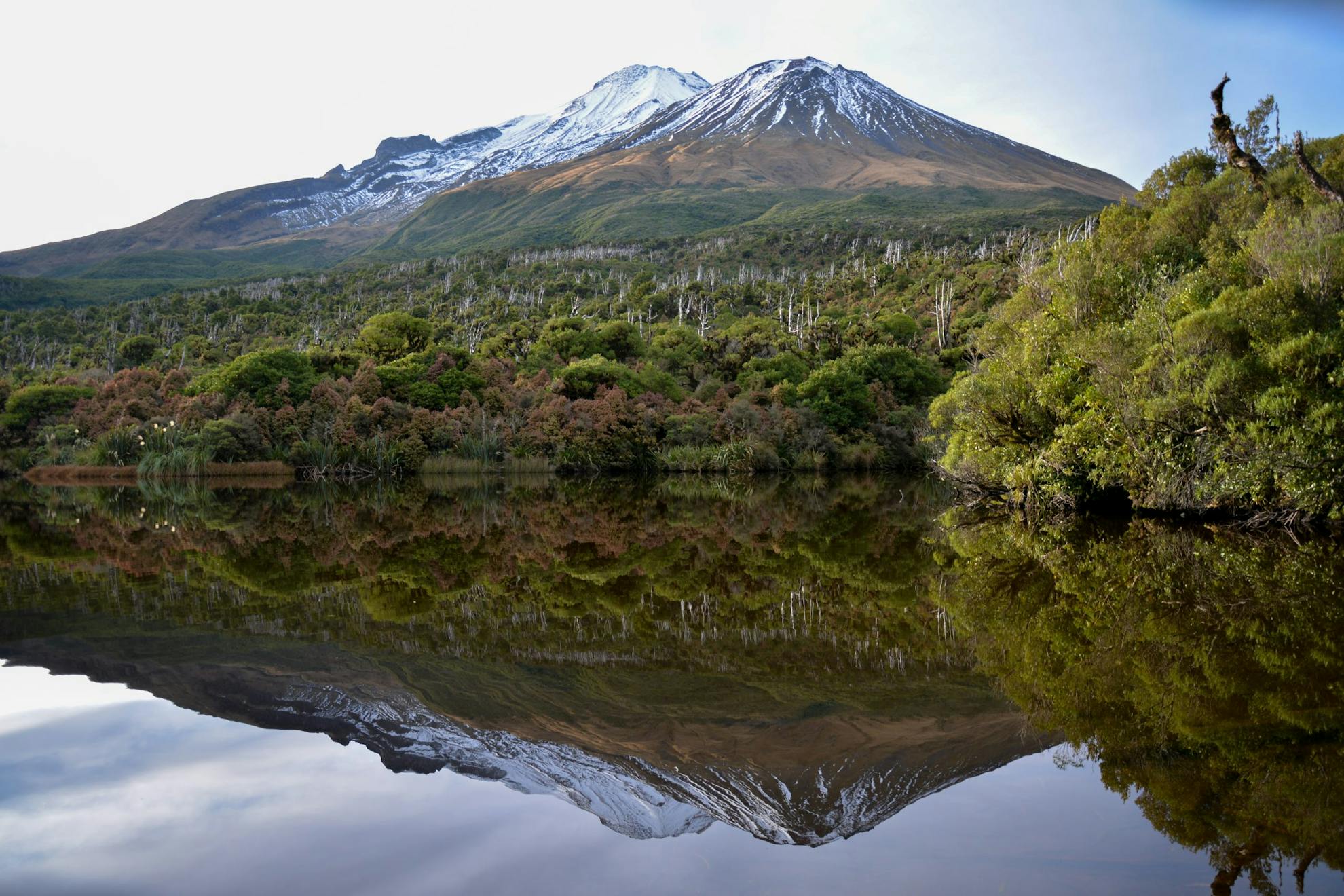
A survivalist and author
The Reverend was particularly interested in nutrition – namely, how much food you should eat to keep your body in perfect health. His idea was that the barest margin of sustenance was desirable, and he reckoned people could endure severe physical hardships for up to seven days without food.
Murray was writing a ‘work’ on the topic and his trip up the mountain was intended to be part of a series of experiments on the ability of a man to survive without food. His companions on the day rejected the idea that his sudden mad break from the rest of the party was premeditated, but agreed that the enforced hardships he would endure from having to survive on the mountain would give him plenty of material to test his theories.
“He was incredibly arrogant, wasn’t he?” Jean remarked to me, and I couldn’t help but agree. I reckon he did it on purpose.
We finish the trip wet but triumphant and as far as aversion therapy goes, it seems to have worked. I’ve spent a couple of days thinking about a summit trip and perhaps an overnight trip to Syme Hut to bag Fanthams Peak. The mountain is shrouded in mystery, stories to be told, secrets to be unlocked.
Other human remains were discovered on Taranaki during the search for Murray. Three skeletons were found in a cave on the western face of the mountain. But that’s a story, and a trip, for another time.
- Distance
- 46km
- Total Ascent
- 3466m
- Grade
- Moderate / Difficult
- Time
- North Egmont to Kapuni Lodge, 8hr; To Waiaua Gorge Hut, 8hr; To Kahui Hut, 4hr; To Holly Hut, 5hr; To North Egmont, 3.5hr
- Access
- North Egmont Visitor Centre
- Map
- BJ29
GPX File
- Around-the-Mountain-Circuit (gpx, )
GPX File
- Your device does not support GPX files. Please try a different device.





